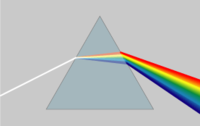
Photo from wikipedia
Abstract The paper aims to study the characteristics of the wave propagation paths in reinforced concrete and to improve the existing velocity models. Therefore, coefficients of reflection and transmission with… Click to show full abstract
Abstract The paper aims to study the characteristics of the wave propagation paths in reinforced concrete and to improve the existing velocity models. Therefore, coefficients of reflection and transmission with regard to energy were analyzed for each component of the reinforced concrete (cement matrix, aggregate grains, air voids and reinforcement bars) in case of a free- and joint-material boundary, respectively. The findings were employed to investigate the wave propagation paths in cracked concrete and reinforced concrete. Three-dimensional numerical models to approximate the heterogeneous concrete (numerical concrete model, NCM) and reinforced concrete (numerical reinforced concrete model, NRCM) were implemented in a rotated staggered-grid finite-differences scheme. Numerical simulations of the elastic wave propagation were performed to illustrate the interaction of waves with boundaries. Both velocity models, NCM and NRCM, were applied to localize acoustic emissions (AE). An established source localization estimation method (FastWay) served as a tool to validate the heterogeneous velocity models. FastWay was applied to a synthetic cracked reinforced concrete beam to localize six randomly located AE sources. The influence of non-straight wave propagation paths on the performance of the localization method was discussed.
Journal Title: Journal of Sound and Vibration
Year Published: 2021
Link to full text (if available)
Share on Social Media: Sign Up to like & get
recommendations!